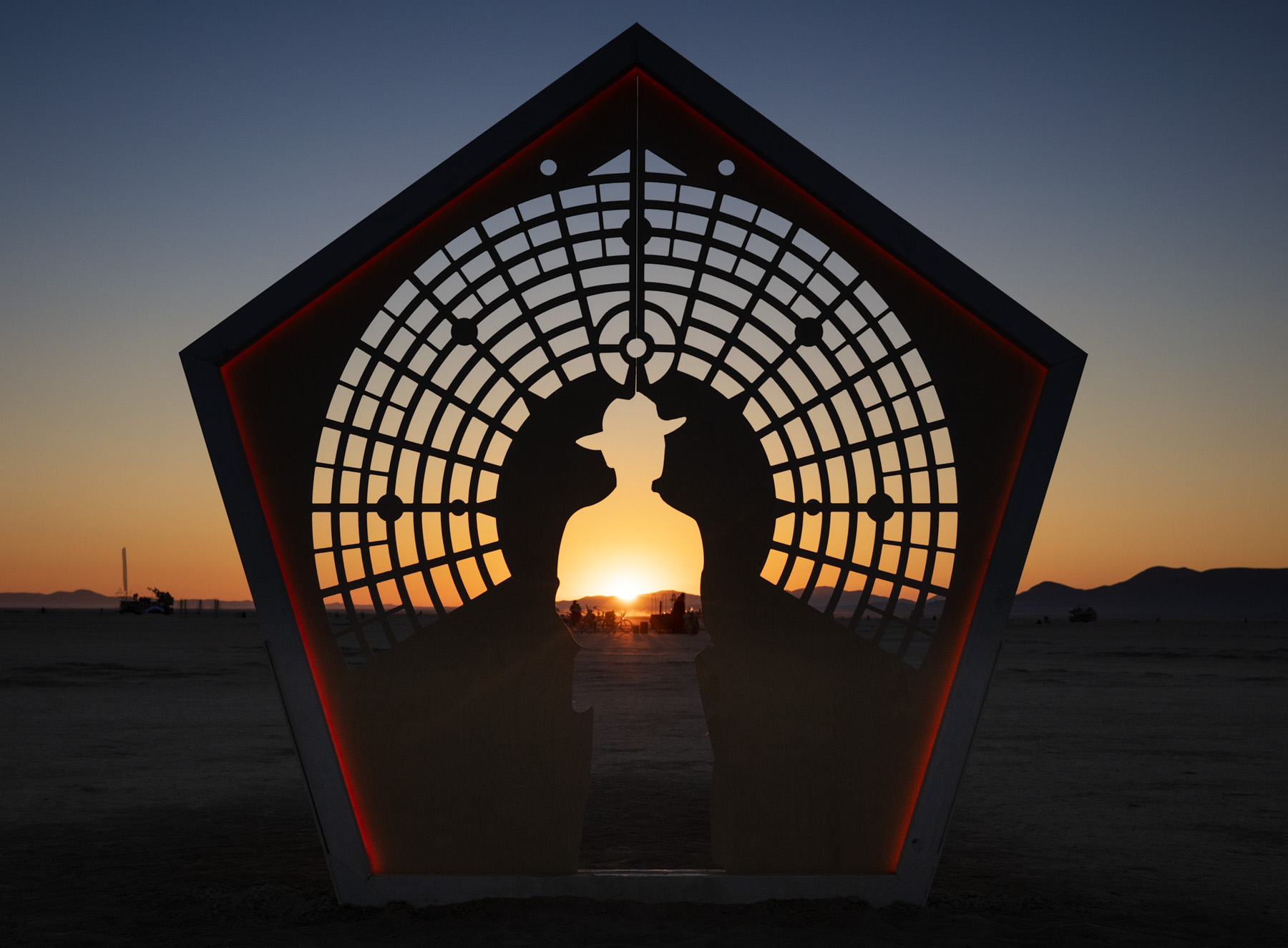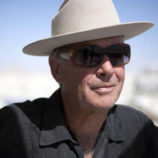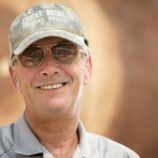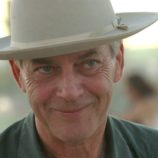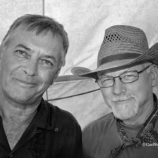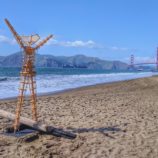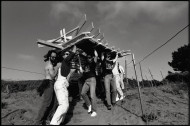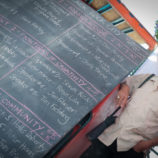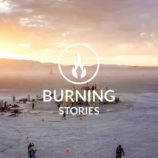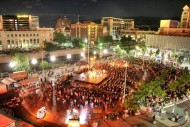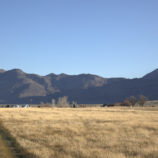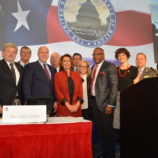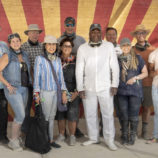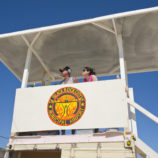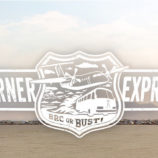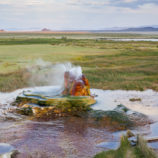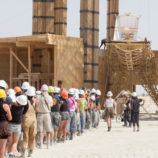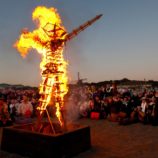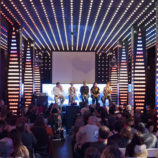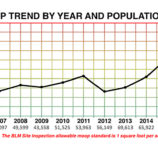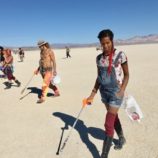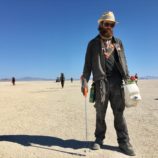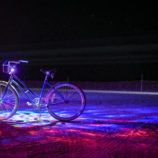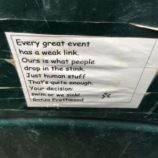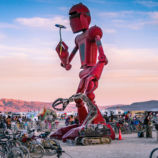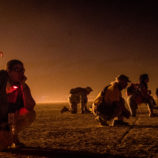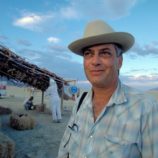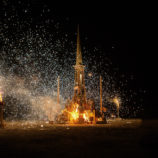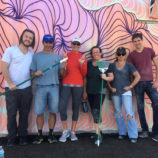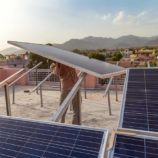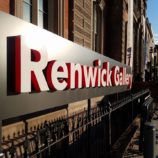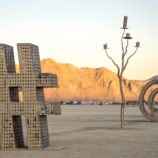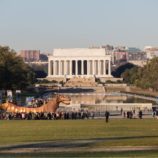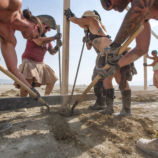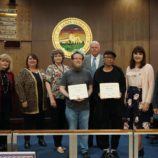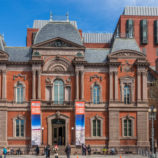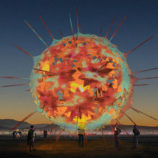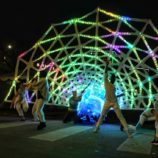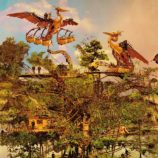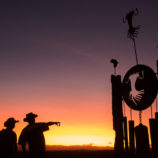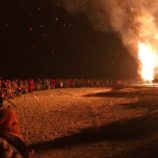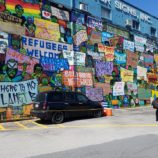The AfterBurn is our annual look back at the past year in Burning Man history — its ups, its downs, and its get-back-up-agains. Burning Man Project, the official name of the nonprofit Burning Man organization, is operated and supported by thousands of people who take responsibility for making Burning Man happen in the Black Rock Desert and around the world. The AfterBurn Report includes what our various departments do, why they do it, what changes occur year to year, our successes and failures, and our vision for the future.
Browse past years’ AfterBurns here.
We also publish an Annual Report each year about our overall vision, impact, and health as a nonprofit, including a snapshot of our finances.
Burning Man 2018: I, Robot
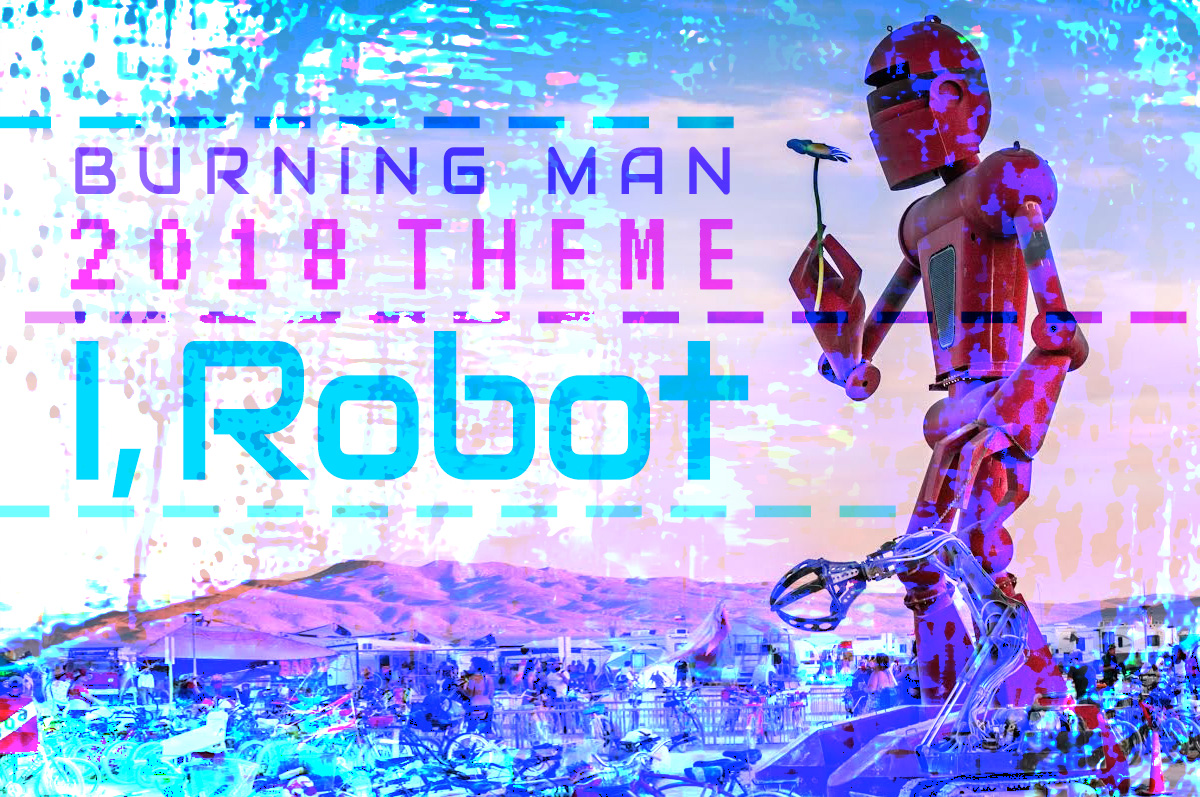 Theme Series: I, Robot
Theme Series: I, Robot
In 2018, Burning Man Project continued to deepen its work both on playa and beyond. We playafied places and spaces as more cultural, public, and private institutions sought to learn from and collaborate with Burning Man, including the Smithsonian American Art Museum, Washoe County, the City of San Jose, and the French creative city, Nantes. We shared the impact of our culture on cities and learned more about their challenges by engaging with mayors from across the country at the U.S. Conference of Mayors in Washington D.C. and Boston. We also hosted a group of 14 mayors on playa.
From cityscapes to landscapes, Land Fellow Scirpus documented the wildlife and ecosystem at Fly Ranch, identifying 144 plants, 88 birds, 14 animals, and 10 reptiles, fish, and amphibians. We also supported the global community’s ongoing desire to learn more, share what they know, and build on what they have. This included supporting the annual Theme Camp Symposium in San Francisco; academic projects from MIT Media Lab and Finland’s Aalto University; the first academic conference on Burning Man and transformational event cultures which took place in Fribourg, Switzerland; a range of leadership summits across the Regional Network; remote trainings; “Critical Conversations” on top concerns of the Regional Network; and a Regional Event Lead Mentorship Program on playa.
In Black Rock City, artists and participants really took to the I, Robot theme with every imaginable robot brought to large-scale or costumed life, including the “Step Forward” giant puppets from Spain and the “Color Wheels” from France. More abstract concepts were also on display in artworks and events, with many highlighting questions about technology and our past, present and future relationship with it.
The separation of the Temple grant and Honoraria grant programs meant we selected and notified the 2018 Temple artist, Arthur Mamou-Mani, three months earlier than in past years. This allowed for a complex Temple design and made it more feasible for an international artist to lead the project. The result was Galaxia, a stunning swirl of petals with a 200′ diameter.
The Man — and the event itself — took on particular significance this year after one of the original builders of the Man and founder of the Burning Man event, Larry Harvey, passed away on April 28. Shockwaves rippled out across the global community, from the hub of people who worked closely with him day in and day out in San Francisco, to people in Regional communities who had never had the opportunity to meet him but felt his role in founding the event that had helped transform their lives.
On June 21, Burners across the globe took a simple invitation to honor Larry’s legacy and turned it into a truly Global Day of Celebration and Gratitude. Closer to Larry’s Bay Area home, the community gathered for a burn at Ocean Beach and again at the Castro Theatre in July for a night of storytelling, performances, music, and art. At the event, the community continued to celebrate and commemorate Larry in their own idiosyncratic ways — from a little red flying saucer and a memorial built by Temple-builder David Best, to the joyous celebration of a New Orleans-style procession to the Temple. The Temple crew, while determined to not turn the Temple into a mausoleum for Larry, included a fitting tribute by Larry’s old friend and co-builder of the first Man, Jerry James. But Larry has had the last word about his life’s passion, as his writings and ideas will live on as foundational texts of Burning Man culture.
(Photo: Passage Home by Kate Raudenbush, photo by Scott London)
Table of Contents
For complete descriptions of the various Black Rock City teams, visit the Teams page.
Burning Man Project Staff and Operations
Stuart Mangrum from Education writes: 2018 was another growth year for Burning Man Education. E-learning development continued to expand, with online courses delivered to staff members in support of People & Operations, Legal, Volunteerism, and Event Operations teams. Our reorganized volunteer Documentation Team supported an expanded schedule of on-playa video projects and collaborated with BRC Webcast volunteers to produce our first successful off-playa streaming event, live coverage of the Theme Camp Symposium that drew over 700 online participants.
The Education team supported the Theme Camp Symposium and other live learning engagements, including a two-day staff onsite retreat, by assisting with content design, speaker preparation, facilitation, documentation, and evaluation. We worked with BRC departments to develop new online trainings for 2019, exploring a multi-year production cycle that incorporates video from last year’s event into next year’s staff training. We supported academic projects from institutions around the world, including researchers from MIT Media Lab and Finland’s Aalto University.
Working collaboratively with the Esalen Institute, we successfully presented two prototype courses based on internally developed curricula: a four-day intensive program in collaborative leadership, and a hybrid-learning version of our cultural ambassador program that included a four-hour online pre-course in Burning Man’s history, followed by four days of onsite work focused on philosophical topics and storytelling skills.
Nicole Rodney from the Documentation Team writes: Our on-playa team meeting was held at a small camp in the “suburbs.” Despite a horrific, choking, blinding dust storm, almost the entire team showed up and exchanged ideas, greeted new volunteers, and reunited with old friends. We encouraged a buddy system for more seasoned members to team up with the new folks. We reinstated giving pins for 10 years of service on the team. This was appreciated by everyone. The team spirit was palpable, and it wasn’t just the dust.
This year, with pre-event assignments, volunteers had a much better idea of what they were to do on playa. We wrote descriptions of the assignments and allowed everyone to chose the ones they wanted. They were sent a survey and then rated their interest. We heard no complaints, and everyone got their work in on time or contacted us for extensions.
We had a record 45 team members, including seven newbies, uploaded 3,000 images to the Burning Man Gallery, and have seven videos in post-production.
Josh Lease writes: The Fellows Program completed the Land Fellow experiment with Scirpus living at Fly Ranch and documenting the wildlife and ecosystem. Her work produced hundreds of gigabytes of data we are still processing.
In 2018, we tried to see what the Fiscal Sponsorship could really do if we took away one major limitation cited every year by participants and potential participants: The fee was just a little too high. After deliberating over various fee structures, we lowered the fee for all participants to a flat 3%. This would not cover labor spent on the program, and it would only barely cover transaction costs, but it would make it a great deal cheaper than most similar programs in the country. What we saw was a typical rise in the number of projects in the program; however, we saw a 967% increase in the amount of money donated through the program. This is amazing for all the projects involved. Unfortunately, it pushed the capacity of this program to its breaking point. We were forced to close the program to new applicants until we were able to catch up with the backlog and the massive volume of inquiries we received. This program is still closed, and we are still digging our way out. This taught us many lessons about our process and gave us more insight into how much or how little this program supports our mission.
Doug Robertson from Finance writes: Finance and Accounting had a busy year processing many transactions, preparing the organization’s tax return and audit, and handling the day-to-day operations. We are proud to report that the audit results were excellent.
Lisa Nash from Nevada Properties writes: We had the first wedding at the ranch in the five years I have worked here. Two members of our extended season teams met here two years ago and were married on the ranch in October. We moved a metal art piece to the rear of the property, with Fly Geyser and the Granite Mountains in the back ground. It was beautiful and a wonderful celebration of their marriage.
We refurbished five of the old trailer houses in the Trailer Park this year. The Nevada Properties (NVP) teams worked for over 10 months to make them a more welcoming environment for our staff to live in while living in Gerlach for almost three months of the year. It was quite an accomplishment and we are very proud of the effort and results of our labors. Our teams (Ranch, AutoShop, Common Shop/Kitchen) actively participated with the Fly Ranch team to assist in making their work weekends and camping trips successful this year. We were in a support role, but it was wonderful working with them and being able to assist this growing and developing team in furthering their goals. Our teams revamped the layouts for camping, trailers and living in Gerlach for this season.
We have more work than can be done each season, and in order to successfully provide working and living spaces for all Burning Man teams that need to use the facilities out here, we need a bigger lead time to adequately prepare. We are working on revamping the management of the NVP world. We need to expand our staff and managers and reduce work loads by spreading our responsibilities. We will continue to upgrade our living spaces in Gerlach for the ever-growing number of staff from all departments that utilize these spaces. This will include refurbishing a few more trailer homes, possibly expanding useable space at the Showers Property, providing more camping space and being creative in meeting our housing needs. We have learned that seven to 10-month terms out here are really hard on the staff, and we need to get creative in how we hire and schedule our work loads. We need to consider breaking terms up into shorter time periods while still having the continuity we need in order to work efficiently.
We had more volunteers than in the past. We usually have three to four rotate through during a season, and this year we had nine volunteers working with us from time frames of two to four weeks. This included four new volunteers.
It was a good year. Tough and some new challenges, but despite being shorthanded at times, we got everything we needed done and my teams were still in good spirits at the end of the season. That is the best I can ask for in any year.
Marci Bennett from People & Operations writes: This year, while always filled with ups and downs, was one where we really worked our processes and they started to feel solid. People understood more how to plug into the services our team offered and we were able to help a lot of staff!
We ROCKED it with site visits this year. We got out to more teams than in previous years: to check in, learn about what they do and how they do it, and get face to face time with many more of the wonderful staff we support. Specific team highlights: working in the DPW bike shop, and providing snacks and water to those in need with the DPW fluffers.
Our volunteer shifts started to gel a bit more, but one we feel that the coaching role was under-utilized. Especially with our new neighbors from Volunteerism whose lovely volunteers were offering peer support! Next year I think we’ll try to integrate forces more and offer more training earlier to our volunteers so they are ready to hit the ground running when they get to playa.
From the Journal:
Fly Ranch
Matt Sundquist writes: On playa, we drove around in our bus and asked people if they wanted to come on a magical adventure. We didn’t tell them where we were going or what we were doing. Then we drove them over to Fly for a surprise adventure – we took them for a walk and a soak, and gave people towels and water. Then, as each of the three panels we hosted on playa came to a close, we drew names out of a hat and loaded people on the bus for a walk and soak. We brought over 100 people who had not planned on going to Fly when they came to BRC. That changed the narrative for at least those people and people they told – it became an accessible and in-motion project.
Of the 12 work weekends we held this year, the last was the most eventful. We had 25 people come out November 9–11 and brave the cold. It got down to five degrees. With that crew, we built a shed for our batteries and inverter. We installed a 15-panel solar array. We cut down a Russian Olive tree, our first invasive species removal project. We installed a composting toilet. We finished clearing the property. And we used the sauna and hot springs. This was probably the model we’ll use for having open work weekends every week or two in 2019.
We’d like to have open camping trips for people to attend. We’d like to scale our training and team for doing geyser guardian shifts. We’d like to do more pro-active communication with the community. We’d like to get in a good cadence with the zoning and building folks, who are going to need to approve of a number of new things or changes we’d like to make. We’d like to start a Friends of Fly pilot project.
So far, six guides have run 130+ walks with 1,400+ people. These walks have generated $50K+ from tickets, which has been split with Friends of the Black Rock High Rock. There were 60+ new members of Friends who joined after walks, a predictor for us. We held 11 camping trips with 400+ people. Twenty-one guardians covered 48 shifts. We took 200+ people on 11 BRC walks. Scirpus, the Burning Man Project Land Fellow, identified 144 plants, 88 birds, 14 animals, and 10 reptiles, fish, and amphibians.
From the Journal:
Government Affairs
Marnee Benson writes: This year, Burning Man engaged with mayors from across the country at the U.S. Conference of Mayors in Washington D.C. and Boston, and hosted a group of mayors in Black Rock City. For Reno Mayor Hillary Schieve, coming to Black Rock City is familiar territory, but for the rest of the mayors, this visit was a first. A lot of careful preparation and planning, and some good fortune with the weather, produced an exceptionally fun and fruitful day on the playa.
The U.S. Conference of Mayors (USCM) has been super supportive, including passing a Burning Man resolution in June encouraging mayors to support artists, innovation, and inclusivity. We, in turn, have learned a lot about the challenges and successes in cities, and how Burning Man values and culture can support civic efforts. We are so fortunate to work alongside Reno Mayor Hillary Schieve to bring cities together around shared values of community, art, innovation, and leadership, and we were thrilled to host mayors in Black Rock City. We’re looking forward to learning more from these dynamic leaders and to expanding our reach in 2019 and beyond.
The Government Affairs team has moved our 10-year permit process forward in a year with unprecedented changes in government and policies at the federal level. Overseeing Burning Man’s Environmental Impact Statement, our team has facilitated numerous scientific studies on site and evaluated the results, created presentations, participated in public meetings, analyzed growth and economic impact, complied with countless requests and requirements, and worked very closely with Black Rock City to evaluate operational impacts. The sheer volume has been intimidating! All that hard work is paying off, as the EIS is on track to be completed next year.
In 2017 we experienced rogue operators along Hwy 447, on Tribal lands and also off the reservation. These operators were collecting trash and recycling from people returning home from Burning Man, charging a fee, and then abandoning the site. There were also high numbers of abandoned trailers and vehicles left for weeks along the side of the roads from Gerlach to Wadsworth. This type of behavior puts the terms of our permit at risk, so it’s important it not happen again. Through our year-round work with the Pyramid Lake Paiute Tribe, the Nevada Department of Transportation, Playa Restoration, and Burning Man Communications, we were able to make a huge improvement. Many thanks also to the Burner community for practicing Leave No Trace both on and off playa, and for recognizing the importance of being good stewards and respectful neighbors. Well done!
From the Journal:
Technology
Heather “CameraGirl” Gallagher writes: The network we build to produce BRC was great, in fact better than ever. We implemented a purchasing system for our DPW and Build teams. We moved our Internal Feedback System (Ember) to use a similar system to the one that the Participants use. Our BMIDs were produced earlier than ever by Tech and available for pick up by our August staff meeting, The Way It Is.
Volunteerism
Kez Quin writes: The new Volunteerism Department has made one full trip around the sun, and we believe we made the most of it! In collaboration with the Education department, we created and rolled out a new training program for our Volunteer Leadership. We also teamed up with People Operations and put together the new Volunteer Peer Support Counseling team for year round counseling and support of all our Volunteer teams. We also started our collaboration with the Tech department to upgrade and streamline our Volunteer Questionnaire and database. We hit the ground running, but we know we have much further to go.
We are very happy with the new Training Program for Volunteer Leadership, new and seasoned alike. The program includes an on-line interactive element followed by a digital handbook, as well as opportunities for live Q & A sessions with highly experienced Burning Man Volunteer leaders. We also offered multiple sessions in specialized areas for more in-depth leadership training, such as Conflict Resolution, Giving and Receiving Feedback, Non-violent Communication and more. Our plan is to continue to add to our training offerings to help our Volunteer Leaders be as confident and successful in their roles as possible.
We are also very excited by the rollout of a new Volunteer Peer Support Counseling service. This service is solely for the purpose of helping managers with volunteer related personnel issues. It’s there in the event that a situation arises where having a neutral third party present would be beneficial to help mediate and guide, whether in the heat of the moment or the middle of the workday. We brought on 14 professionals trained in the fields of conflict mediation, counseling, peer support and mental health, and the response from BRC volunteers was overwhelming — from all those that took advantage of the service to those that told us they were “just happy to know you are here if I need you.”
We definitely learned some lessons when it came to working with a group of volunteers involved in a single counseling situation. New discussions and planning are already happening on best practices there. We also learned some dos and don’ts when planning for on-playa training sessions. We are working with People Operations to figure out what we can do next year to have valuable training sessions more accessible for the most people.
So far we’ve enrolled 76 volunteer leaders in the new training program, and of those, about half have completed it. The average score on a scale from one to 10 on “whether or not users would recommend it to other volunteer leaders” was 8.9. It scored an average of a nine for “relevance to their work” and 8.75 on “whether or not the content will be useful in their work”. On playa, our Peer Support Counselors spent over 28 hours in 22 active counseling sessions with volunteers from 13 different teams. We’ve already been contacted for additional support counseling off playa. This bittersweet data makes us very glad this resource is now available for the people that build and support Black Rock City.
Black Rock City Event Operations
The loss of Larry Harvey had both emotional and operational consequences for the event this year. People from across our global community were gripped by a deep need to gather on playa together, and we had the highest turn-out rate we’ve ever seen. The event itself opened with a bang as intense whiteouts on the Sunday saw the Gate crew earn their stripes as they processed arriving participants in crazy conditions. The Gate Team also re-established the official opening of the gate with a 500-foot line of large-scale art cars and a pyrotechnics show at the stroke of midnight, while the DMV went big this year by helping the Big Imagination project to safely operate their 747 during the event. Meanwhile, the Placement Team initiated the Black Rock City Cultural Direction Setting project, which began a conversation with the community about the 5–10 year vision for residential Black Rock City. The Communications Team led the charge on its second year of Project Citizenship, which aims to to address some concerning behavior in our beloved city. Previous work to raise awareness about medical self-reliance also produced results, with Emergency Services reporting a steady decrease in the number of people requiring minor care at their stations. And to round it all off, the Department of Public Works broke a record for completing its first pass of the City Grid in just five days, and it helped us pass both Bureau of Land Management inspections — despite what a local newspaper reported.
Airport
Dee Zaster from BRC Airport writes: We experienced communal growing pains this year. A few short years ago there was only one camp at Point 5, but now the community additionally includes two work support camps CamPlex and FlyByNyte, Staff Operations Camp, and a conglomeration of 18 individual groups in what is now called Legacy Camp, not to mention dozens of pilots who camp inside the fence or under the wing.
We added a new medevac runway that specifically served the needs of emergency flight team and which also alleviated stress on Willie’s watering team, allowing them expanded access to the main runways and a quicker job watering.
We had some hair-raising adventures this year, including a very dusty Sunday with heavy ingress during which time our runways remained open. We were forced to close our landing runway twice due to high-speed law enforcement vehicle incursions (plural). We also hosted, albeit briefly, a planeload of lost tourists and our friends at Burner Express Bus saved the day!
In 2019, we will roll out new acculturation initiatives for Point 5, especially for those who are new to Black Rock City. The Airport is a portal to Black Rock City, and we want to be sure folks are properly acculturated from the moment they arrive, as well as before.
88NV hosted over 3,200 flight operations during the 2018 season, which works out to one takeoff or landing every 2–3 minutes between 6:00 am and 6:30 pm every day for 13 days straight! And — the most Burning Man part — individual Burner pilots gifted over 700 flights to participants.
Burner Express
Audrey Whaling from Burner Express writes: Burner Express Air had several new air carriers, including a helicopter carrier named Maverick. They brought six helicopters to the playa for BxA. They frequently offered scenic flights to participants and staff and really took on the Burning Man ethos. It was wonderful to have them on board, and we’re looking forward to working with them in 2019. We worked with a newly established charter group called Dusty Charter, Inc. While there was some turbulence, it was overall the smoothest year since the inception of the Burner Express Air program in 2016. We flew in 2,390 participants to BRC and flew out 2,302.
The Burner Express Bus team finally hit their stride this year. We had a few returning team members in new management positions, and they totally KILLED IT. We also had a new volunteer coordinator who rocked it with a new slew of volunteers. We also surpassed our goal of 15,000 with 15,305 riders!
There were insane whiteouts all day on Sunday of ingress. At one point the Gate held traffic and buses for safety reasons. After some coordination, the Gate staff led in approximately 15 buses to the BxB Depot where the team met, greeted, processed over 750 participants in about 15 minutes. It was an incredible sight to see.
From the Journal:
Communications
Dominique Debucquoy-Dodley writes:
The Communications team took the lead on the second year of our a cross-departmental push to address some concerning behavior in Black Rock City, Project Citizenship. Our focus areas for the year were: 1) Sexual Assault Awareness and Resources 2) Celebrate the Small 3) Decommodification 4) Personal Responsibility. Our flagship campaign continued the email push titled “From the Desk of Charlie Dolman,” with five emails focusing on our key messages sent to both Pre/Main Sale ticket buyers as well as DGS ticket buyers. Rusty Blazenhoff returned to craft the voice of these emails, and the Communications team worked collaboratively to tweak the messaging.
The content on our Instagram feed was intentionally shifted over the last year. Through guest posts, customized graphics, new hashtags, and video projects, we’re celebrating one of the key components of Burning Man culture: the work is just as important (and oftentimes just as much fun) as the play.
In an effort to make sure the content is available to anyone who could not attend the Theme Camp Symposium in person (capacity was limited to 250 participants), we live-streamed the first half online. Produced in cooperation with Motorbike Matt from the Burning Man Webcast team, the stream drew more than 600 live participants and has had over 5,000 views. Like any city, Black Rock City is unfortunately not immune to the realities of sexual misconduct. In 2018, as part of Project Citizenship, there was a multi-department effort to update and consolidate information about the related resources available to anyone who may need them. In a push to reduce waste and help leave no trace, the Tip Sheet was combined with the Bureau of Erotic Discourse + Zendo handout.
At the invitation of Reno Mayor Hillary Schieve, Burning Man Project attended and spoke at the winter meeting of the US Conference of Mayors in Washington D.C., and attended the spring meeting in Boston. The Communications team supported a group of mayors from across the country who came to visit BRC in 2018.
The Comms team hired a Project Manager in 2018, with the role focusing on long-term projects like our print production materials, Speakers Bureau support, and on playa logistics. We received 90 requests for long-form interviews or speaking engagements in 2018. We participated in 52. We published 188 posts on the Burning Man Journal.
In April 2018, our founder and original instigator Larry Harvey passed away. The Communications team supported several efforts in his honor, including the global celebration on the summer solstice and the Man With the Hat tribute event in San Francisco.
From the Journal:
Burning Man Information Radio (BMIR)
Joshua “Kanizzle” Cunningham writes: Back in 2005, a gentleman by the name of Bobzilla showed up at BMIR’s door, said he had some radio experience, and that he’d love to help out. Fast forward to the present moment, and Bobzilla has been a crucial contributor to the evolution of BMIR to its current state for the past 13 years. From starting as the Production Director in his second year, to Co-Project Manager the past seven, Bob worked his way up the ranks and helped define what BMIR is in the eardrums of the citizens of Black Rock City.
Before the 2018 event, Bob let the rest of the team know that this would be his last year in management, and we made sure he had the farewell he deserved! What sort of party did we throw him? A two-week escapade of the best radio we’ve ever created! From intriguing storytellers to mind-blowing live musicians, incredible music selectors to compelling interviews, BMIR stepped up our game this year with what we consider to be the best set of programs we’ve ever had the chance to deliver to your radio. We’ve put a challenge out to our staff to up their game the past few years, and it’s being realized in an incredibly palpable way through the airwaves. A justifiably perfect send-off for Bobzilla if we do say so ourselves!
Census
DV8 writes: This year was a great year for BRC Census, with almost 200 volunteers on playa! While we had the occasional hiccup, things ran extremely smoothly overall. Our folks worked hard and had fun, and a lot of data was collected, analyzed and reported. We even had time to go to Burning Man and have some fun!
Our work support camp coordinators put together several new social opportunities, both for Census volunteers and for the public. We’ve always wanted to give our volunteers more opportunities to get together and hear how much we appreciate them, and we were thrilled to make it happen this year.
We also made some technical improvements to our data entry process that made it easier for our volunteers to check their work as they went along. (We actually started work on this in 2017, but it took until 2018 to really get it dialed in.) This made a huge difference on the data analysis side and we were able to get preliminary results compiled much more easily than we have in the past.
The main complaint we heard from volunteers was that traffic patterns on Gate Road biased traffic heavily toward lanes 1–5, leaving some bored volunteers in lane 6–10. We were able to mitigate this somewhat by rotating volunteers through the busy lanes and increasing the sampling frequency in the quiet lanes, but it still caused some frustration. We’ll see what we can do next year to resolve this.
Our random sampling process discovered that BRC had fewer virgins on playa this year (around 32%) compared any of the previous five years. The highest it’s been in the last six years is 39% in 2016; the lowest it’s been aside from 2018 is 35% in 2014. Our survey response rate wasn’t quite as high as it was for 2017, but we’re still up from 2016. Huge thanks to everyone who participated!
From the Journal:
No posts matching your selection
Media Mecca
Dominique Debucquoy-Dodley writes: Once again, in an effort to push for quality over quantity, we focused our media project proposal review process on reducing the overall number of BRC media projects. This allowed our Media Mecca volunteers to provide more comprehensive guidance on higher quality work, and several fantastic pieces came out of the 2018 event. This year, we received 271 applications to cover the event, and we accepted 176. In addition, 28 conclave documentation projects were accepted.
Media Mecca also hosted a special storytelling event in honor of our late founder, Larry Harvey.
Community Services
Dee Zaster from BRC Airport writes: We experienced communal growing pains this year. A few short years ago there was only one camp at Point 5, but now the community additionally includes two work support camps CamPlex and FlyByNyte, Staff Operations Camp, and a conglomeration of 18 individual groups in what is now called Legacy Camp, not to mention dozens of pilots who camp inside the fence or under the wing.
We added a new medevac runway that specifically served the needs of emergency flight team and which also alleviated stress on Willie’s watering team, allowing them expanded access to the main runways and a quicker job watering.
We had some hair-raising adventures this year, including a very dusty Sunday with heavy ingress during which time our runways remained open. We were forced to close our landing runway twice due to high-speed law enforcement vehicle incursions (plural). We also hosted, albeit briefly, a planeload of lost tourists and our friends at Burner Express Bus saved the day!
In 2019, we will roll out new acculturation initiatives for Point 5, especially for those who are new to Black Rock City. The Airport is a portal to Black Rock City, and we want to be sure folks are properly acculturated from the moment they arrive, as well as before.
88NV hosted over 3,200 flight operations during the 2018 season, which works out to one takeoff or landing every 2–3 minutes between 6:00 am and 6:30 pm every day for 13 days straight! And — the most Burning Man part — individual Burner pilots gifted over 700 flights to participants.
Marcia Crosby from Center Camp Café and Arctica writes: Café and Arctica switched over from cash registers (and the problems that come with using that 20th-century device) to iPads as registers, and they were very user-friendly, easier to train new volunteers to use, and they sped up the process for participants such that our lines moved much faster.
We had volunteers create robot head lanterns from cardboard and plastic discards, and then taught them correct recycle-sorting during take-down as the volunteers took apart the decor and correctly sorted it for recycling.
We increased the number of volunteers-as-trainers for all the roles in the Coffee Shop, so we had trainers available at every shift. We also noted fewer no-show volunteers who signed up for a shift. 1,475 volunteers signed up for a shift in the Coffeeshop in 2018.
Successful succession planning came to fruition in 2018. We brought on a new Arctica Operations Manager, replacing the 15-year vet who retired after the 2017 event.
Michael Wolf from the Department of Mutant Vehicles (DMV) writes: In coordination with a number of other BRC departments, the DMV successfully worked with the Big Imagination project to enable them to safely operate their 747 during the event. As part of our ongoing effort to maintain the safe operation of motorized vehicles, this year we handed out dashboard stickers to vehicle operators with a checklist of five key rules for safely operating a vehicle on the playa, as well as a reminder of the consequences of improper behavior.
To better meet demand, we extended our operating hours by one hour on peak days, and also experimented with a fast-track inspection process, both of which were successful in improving our ability to inspect and license vehicles during our busiest days at the beginning of the event. With improved signage, the DMV again facilitated the Burn Area Imprecise Transport (BAIT) program, where mutant vehicle owners provided transportation for participants along five routes through BRC to the Man and then the Temple, as well as out to the airport.
In 2018, DMV registered 618 mutant vehicles, as well as 404 vehicles for disabled participants. For historical context, the number of mutant vehicles is roughly the same as the prior two years, and is below our high of 650 in 2015. The number of vehicles for disabled participants continues to rise, on a trend of 17 more each year since 2015.
Karina O’Connor from Earth Guardians writes: We expanded our Leave No Trace outreach efforts earlier in the event and had higher resolution rates on reported issues this year! We added new shelters to keep our hot spring volunteers shaded. We also started a new program for activities this year called Eco Socrates Cafe. It offers space for Burners to assemble and talk about environmentally themed topics like Burning Man’s carbon footprint. The two events were well attended, so plans are to continue the program in 2019 and maybe offer solar-cooked tea to participants to make the atmosphere more like a cafe. We also had a record nine bike tours that were very well attended, seven of which highlighted the natural history of the playa, two of which visited “green” camps.
Earth Guardians had 500 volunteer shifts, over 1,000 LNT issues identified, a resolution rate of over 90%, over 4,000 LNT outreach contacts, additional contacts during many of our public events and processions, camp set-up in three days, camp tear-down and container packed in two days!
Dick Tracy from Greeters writes: The operations effort at the station this year was fantastic, with everyone pitching in to drive a timely, safe and efficient set-up and take-down. During Build Week, we celebrated several Greeters who reached 20 years of Burning with a recognition ceremony attended by the Collating Crew, friends and family. Greeters were lucky enough to participate in two Burn Perimeters, Panda Burn and the Temple Burn. The Collating Team took in over 200,000 stickers, 78,000 Tip Sheets, 82,000 maps, 80,000 recycle cards and 79,447 WhatWhereWhen Guides into welcome/information packets. Eight hundred Greeters welcomed new and old Burners alike to the 2018 Black Rock City Burn.
Snotto from Lamplighters writes: We had major changes to our internal management last year. So both of our workspace managers and our kitchen manager were brand new this year and did an amazing job: that’s with our kitchen serving 170 people per night. Just the fact that we have such amazing volunteer pool to pull from is a feat in itself. Just like last year we had over 50% newbies in our camp and along with 30% returning newbies from last year, we didn’t have anyone who didn’t volunteer every day, which is a huge accomplishment for us.
Trippi Longstocking from Placement writes: The Placement Team placed 1,472 camps with 18 volunteers this year. It was a smooth year of operations overall. We improved our systems behind the scenes to review questionnaires faster and respond and document the 10,000+ emails we receive more efficiently.
Our biggest initiative was launching Black Rock City Cultural Direction Setting and the Camp Development & Support Team. This is all in service of expanding how we think about the future of placement, camps, and residential BRC. This project is heavily connected to Placement and also reaches beyond it by including camps, staff, and the community to explore the 5–10 year vision for residential Black Rock City.
We shifted many camps on the Esplanade and avenues this year into new sectors in order to shake things up and lean more into the temporary nature of our city. We received a mix of positive and negative feedback about these changes. Our team was overall happy with the results and the new landscape of the Esplanade in particular.
From the Journal:
Wristy from Playa Info writes: In 2018, we added a new “Break Room” Office Container so our volunteers had a cool, quiet place to sit down and relax, get rehydrated and snack. We added a new, better ADA Desk for our mobility challenged participants to be more inclusive. We also added a second Lost & Found Drop Box to handle the large amounts of found items dropped off after hours. The best story, in my opinion, is about the synchronicity of how the “playa provides.” Late one night, a Ranger approached me as I was walking away from my camp at Playa Info. He had a distraught participant that had lost a backpack with his Insulin. We were able to retrieve the backpack from the Lost & Found Drop Box, and after confirming ownership, we were able to reunite the participant with his property and his meds. It felt like really making a difference.
In 2018, L&F logged in 1969 items, and 966 items (49%) were reunited with their owners while we were still on playa. That includes 721 phones logged in, and 498 returned on playa. Also 639 IDs (driver’s licenses, passports, etc.) were logged in, and 209 (33%) were returned on playa. Lastly, 402 bags were logged in, and 209 (55%) were returned on playa. Those three categories make up 89% of the found items logged in at L&F.
Spanky from Recycle Camp writes: Aside from Crushing It™ with the aluminum can recycling, we just had a great time! It’s awesome when a team really comes together to work hard, make it all happen, and help everything feel seamless. Recycle Camp went up and came down in record time with returning volunteers as well as some first timers and even their kids!
A testament to our planning and our new kick ass Volunteer Coordinator, we had more walk-on and scheduled volunteers than ever before, giving more participants a chance to enjoy the Recycle Camp experience. We also saw more of our reusable mesh bags come back for another year, a great result for our pilot project that helps educate participants on how best to recycle on playa. We also upgraded several components of the Crushinator, our bicycle-powered can-crushing machine.
In our unrelenting quest to make Recycle Camp more awesome every year, we plan to upgrade our can-moving bins, convert more shade to Aluminet and, of course, bigger, stronger magnets! Finally, we’ll need to adjust to having more participants bringing cans earlier in the week. We also need to find a better way to train our new volunteers and handle shift changes.
As usual, we donate the proceeds of our aluminum recycling to the local school system in Gerlach. This year we crushed three 30yd dumpster’s worth of cans and were able to donate $2000! We also kept our budget flat, which is our goal every year.
Jocko from the Volunteer Resource Team (VRT) writes: The VRT placed over 3,000 participants in volunteer roles and/or educated them on volunteerism, with three V-Spot locations in full swing. The VRT itself had over 85 team members this year (we were just over 30 a few years ago). Team leadership more than doubled, from three leads and a VC, to eight leads, three Volunteer Coordinators, Fluffing team and an Office Manager.
This year the VRT hosted a group of seven Swiss Burners to our team and family. We also hosted the European Regional Mixer and expanded our VC shindig to encompass multiple additional groups within volunteerism. Combined with the ongoing development of the 3 o’clock and 9 o’clock VRT locations, the VRT is expanding our reach into the local BRC and international communities.
Marcia Crosby from Temple Guardians writes: We had successful leadership transitions: prior Department Lead moved to Training Lead, prior second in line moved into Department Lead, and it worked beautifully. A new Temple Guardian in 2017 thought the training location was difficult to find, so in 2018 he designed, funded, and built a 10′ tall back-lit sign (and then USA Today used a photo of that to illustrate its Burning Man coverage!).
Department of Public Works
ChAos from the Department of Public Works (DPW) writes: Following a significant informational campaign during spring, there was a 50% reduction in the number of bikes left behind in 2018. We made great improvements to the program for collection of bikes for donation. All the bikes were off playa in a timely way, and the fence came down on schedule.
A major adjustment was made to our production schedule with the goal of reinvigorating the operation that installs the nine-mile perimeter fence. Other work was limited to necessary functions and all staff on site participated on Fence before ramping up regular production efforts. The day was successful and the entire fence was once again in place before 2 pm.
Gerlach is our base of operations for work required before and after the 42 days spent on playa. Major improvements were made to our infrastructure in Gerlach this year. Better planning, layout revisions, enhancements to power infrastructure, new off-site staging for event equipment, safety planning and better staffing all helped to improve living conditions and operational effectiveness during our stay in Gerlach this year.
The core of the Man Pavilion design was shaken with the passing of Larry in 2018. In the wake of that shock, the team pulled together to finalize a design based on what we knew and what we felt Larry would want. The project achieved a lot of strategic goals around engineering, communications and implementation. The Man Pavilion opened on time and had the most painless Strike night in memory. The Man burned, as it should.
In 2018, the DPW Purchasing department began using a new software application that promises to streamline our operations and better integrate them with the Accounting team. Many people still think Burning Man is entirely organic, and much of it is, but there remains the literal nuts and bolts that it takes to put projects together. The Purchasing department works every year to provide those nuts and bolts (and impact drivers, ladders, rigging, etc.) to make infrastructure happen. With the advent of a new back-end system, our capacity should greatly increase as we go forward.
Emergency Services
Kate Gonnella from the Emergency Services Department (ESD) writes: The number of people requesting minor care at the ESD stations is decreasing each year. Granted it’s only by 1-2% per year, but we are seeing a change. We think people are understanding that bringing their own bandages, painkillers, moleskin, etc. is a Burner thing to do. In 2018, ESD and Rampart treated 3,892 people. All ESD sexual assault and domestic violence advocates have at least 40 hours and up to 70 hours of training prior to arriving on playa. We deployed 300 pagers and 2,400 radios.
Gate, Perimeter & Exodus
Buck Down writes: Of the many accomplishments of our team this year, one of the best was re-establishing the official opening of the gate as a curated, produced event. We were able to assemble a 500-foot line of some of the biggest, most famous large-scale art cars lining the road beside apex and, through coordination with the FAST team, we marked the opening of the event with a pyrotechnics show at the stroke of midnight visible all the way to the gravel. The event was covered and photographed by John Curley for the Burning Man Journal.
This was the inaugural year of Black Hole Operations as a free standing sub-department. We created it because we came to grips with the fact that we had a wide swath of deliverables (inclusive of the Black Hole Bar, the camp’s infrastructure, our team of Healers and our fleet of cars), which had been rapidly degrading as a result of not having a full-time manager or crew attending to them. By cleaving these off, we were able to give Central Services more bandwidth to do its first order jobs even better, while upgrading the services that touch almost every single one of our staff and volunteers.
David Crispin writes: GP&E Central Services made a lot of progress in streamlining processes on and off playa. It was our first use of a new office space known as the GO Box, and it was largely successful. We have identified the areas that need work. We opened many things earlier than ever in 2018.
Playa Restoration
DA writes: In preparation for the upcoming Environmental Impact Statement, we conducted the annual Post-Event Inspection twice for the 2018 season in order to test the BLM’s testing methods. Each Test consists of a total of 60 randomly located Monitoring Points of 1/10 acre (37ft radius) within four Core Inspection Areas: City Grid (1,203 acres), Open Playa (1,463 acres), Walk-In Camping (356 acres), and Other (606 acres). Additionally, there are six target-specific Monitoring Points known as Points of Interest: The Man, The Temple, United Site Service, DPW Depot, Heavy Equipment and Transportation, and the BLM. Traditionally, these areas are specifically targeted for testing/continued observation and not counted toward the final total of random Monitoring Points.
Saving you some math, the BLM standard requires us to be under 1ft2 of MOOP per every 43,563ft2 of playa. The final results for Test 1’s 60 Monitoring Points was .77ft2 and Test 2 was .66ft2 , therefore successfully passed the BLM standard.
In the 2018 Post-Event Inspection, the most common form of debris in the City Grid was wood debris (33.33%), followed closely by plastic debris (28.26%), cardboard/paper debris (9.12%), metal debris (7.77%), fabric/textiles/string (7.19%), misc. organic debris (3.97%), zip-tie/twist-tie (2.63%), food debris (1.40%), and paint chips debris (1.05%) to name just a few. The average size debris for all 120 monitoring points was .29 in2 (or just a little over 1/4in2).
On Christmas Eve 2018, the Reno Gazette-Journal incorrectly reported that Burning Man failed the Post-Event Inspection, which was then unfortunately reposted by other news sources. Burning Man and the Bureau of Land Management are actively working to correct the record to accurately reflect Playa Restoration and the Burning Man community’s Leave No Trace success in passing the BLM Post-Event Inspection 2018. Burning Man is proud to be the largest practicing Leave No Trace event in the world and is ready to prove it once again in 2019.
Highway Cleanup saw a 30 to 40% reduction in trash on the side of the highway this year! In previous years, we picked up an average of 180 bags of trash per day during our high-volume trash pick-up days. This year we had an average of 105 bags of trash per day during our high-volume pickup days.
There were only a few abandoned vehicles on the 447, a sharp reduction from 2017. Most of the ones we spotted had moved away by the third day of Highway Cleanup (Fri 9/7).
There continue to be some reports of trash being dumped in Reno dumpsters, Fernley, and Alturas — overflowing dumpsters and scattering. We will double our efforts in educating the BRC community about our Leave Nevada Beautiful campaign, which directs Burners to all of the authorized local trash/recycling/RV servicing vendors in the area.
Bag collections on the 447 have been a problem previously when bag collectors have charged participants to take their trash but have left the trash for us to clean up. This year, a bag collection site reportedly tried to leave their bags again for us to clean up. Unknown sources reprimanded them and they hauled the trash away themselves.
This year Highway Cleanup Manager Sansa interfaced with the Pyramid Lake Ranger who was extremely nice to me and informed them of a few trouble spots on 447. Highway Cleanup immediately cleaned up those trouble spots, including a site where a trailer had fallen over and littered trash. The trailer had already been hauled away by the time Highway Cleanup got there.
All in all, it was a great year again doing Highway Cleanup. It seems that all of the preemptive efforts and outreach with the Leave Nevada Beautiful campaign of all the trash and recycling locations have been paying off and making the roads cleaner.
Four businesses in Cedarville reported that they were very happy to have Burner business and that the Burners were generally polite and well behaved — except for one man who walked into the BBQ place naked (they gave him clothes and still served him bbq!). The Highway Cleanup Crew has been creating relationships with the businesses of the small towns we have been cleaning for years now and we are warmly welcomed everywhere we go.
From the Journal:
Rangers
Lodestone writes: Overall, 2018 was a good year for Rangers. Operations were largely smooth. Communication between Rangers and other departments continues to strengthen. There was a lot of enthusiasm and great sense of community out in the city, and it felt good to be a part of that.
The 2018 Man and Temple Burns were a touching example of community awareness and support. From the Ranger perimeter perspective, it was a very quiet year — any disruption in the crowd was immediately addressed by nearby participants. The tradition of multi-departmental perimeters continues, and the integration of additional mobile resources into the burn command structure allowed quick response to drones and other safety concerns.
Team growth was strong in 2018, with 42 Ranger Trainings offered in the US, Canada, and the UK to 1268 attendees. There were 827 active Rangers on playa, who worked almost 35,000 total shift hours.
Ticketing
2018 was a year filled with change for ticketing. We knew going in that we would be undertaking an exhaustive Request for Proposals process for our next ticketing partner since TicketFly was acquired by Eventbrite. That process began just after the 2017 event and lasted all of 2018, ensuring we did our due diligence to find the best possible partner for where we hope to take ticketing in the near future. Much of the year was also consumed with filling the long-vacant role of Ticketing Coordinator. The loss of Larry Harvey in April had us all reeling. Moved by the loss, the community at large was gripped by a deep need to gather and be together, which was beautiful. This also resulted in the highest turn-out rate we’ve ever seen, which meant we had a few hundred people over our population limit for several hours.
More Event Ops stories from the Journal:
Art & Civic Engagement
In 2018, we shared Burning Man art and culture more widely than ever before, from the recording-breaking number of art works on playa, the growth of Global Art Grants, and the installation of Burner art on the streets of San Jose, to the cultural storytelling in the Smithsonian American Art Museum in Washington D.C. and five commissioned artworks on the grounds of Google, Palo Alto. Meanwhile, Burners Without Borders continued to support a scaling network and to share the tools, skills and resources to help projects become their own organizations and Regional groups to facilitate their own grant processes. Closer to home, community events scaled up with record attendances, bigger and more beautiful venues, and a rocking Decompression.
Art in Black Rock City
Katie Hazard writes: 2018 was a record-breaking year for art. We had 383 art installations on playa, the most ever! The past five years we’ve been in the low 300s, so this was a big jump. In 2018 we were surprised to see the number of registrations growing as the summer progressed. We added additional staff and volunteers to support the pre-event planning and the on-playa placement and installation. There was some last-minute scrambling for additional resources like iPads and golf carts, but we successfully supported 383 projects and managed to do it all safely.
Artists really took to the I, Robot theme with a range of creative expression, from every sort of robot imaginable to more conceptual pieces around technology and our interaction with it. The Burnbots in the Man Pavilion explored the range of possibilities of robots-as-art and burned with the Man.
Several notable installations included performative aspects, such as the giant puppets (“Step Forward”) and the “Color Wheels”. The ORB was the largest installation on playa in 2018 (aside from the Temple), with a diameter of 84 feet.
The international presence on playa is growing. This year there were 46 international art projects from 20 different countries. And the art is trending towards being increasingly complex. Our team continues to work towards welcoming all participants to bring art, encouraging small projects as well as large.
The separation of the Temple grant and Honoraria grant programs in 2018 meant we selected and notified the 2018 Temple artist (Arthur Mamou-Mani) in December 2017, three months earlier than in past years. This allowed for a more complex Temple design. Galaxia was a stunning 200′ in diameter, although its complexity meant that it opened several days behind schedule. Early notification also made it more feasible for an international artist to lead the project.
The budget for funded art increased from $1.2M/year in the past three years to $1.3M in 2018, allowing us to more fully support a greater number of artists.
We continue to have issues with art installations that cause potential safety risks for participants. This year we had to close two complex projects and maintain perimeters around them for the remainder of the event. We want to establish better protocols for situations like this so artists understand their responsibilities and can have back-up plans in place.
Another safety concern is that we don’t have an effective system for demarcating art projects that are still active work sites before they’re open and ready for interaction. Participants often ride their bikes right through cones to talk to artists who are still building. Our team is working to set up a better system of clear perimeters for works in progress to protect participants and allow artists space to work safely.
The Burn Perimeter Support Group (BPSG) is a team of volunteers under the Fire Art Safety Team (FAST). Their role is to set up and maintain the perimeter around each artwork that burns to keep the citizens of BRC safe. This team is in its third year and is experiencing challenges around recruitment and logistics. It’s a big lift for FAST to manage the burns itself and try to staff upwards of several hundred people for each burn. We’re assessing how to improve this for 2019.
In 2018, we created a system for tracking incidents of vandalism (intentional abuse) and damage (unintentional harm) to art on playa. After the event we surveyed all registered artists: 27 artists experienced vandalism (7%) and 54 artists experienced damage (14%). When asked if these incidents of vandalism or damage would discourage them from bringing art to Burning Man in the future, only one said they would be “less likely to bring art in the future.” Overall, artists seem to understand that Burning Man is a harsh environment for art and that intense participation is to be expected. In 2017, without a solid reporting system, we had 15 cases of intentional vandalism. In 2018 we had 27. Out of 383 projects on playa, this amounts to 7% of projects experiencing vandalism. We still have work to do towards educating participants to respect the art but overall we are in better shape than expected.
- 383 total art installations on playa: 72 Honoraria, 16 installations in the Man Pavilion including 12 Burnbots, and 295 Registered projects. Most ever!
- $1.3 million in funding (increase from $1.2M in previous 3 years)
- 46 international projects, from 20 different countries
- Received 507 LOI applications for the Honoraria Program, and 12 proposals for the Temple.
- This year Art Support Services (ASS) fielded 1,075 total service requests on behalf of artists on playa for heavy equipment, fuel, water, decomposed granite, ground anchors, wood, etc.
- Open Fire: 14 projects plus the Temple and the Man for a total of 16 art installations that burned
- Flame Effects: 15 art installations, 74 theme camps, and 130 mutant vehicles
From the Journal:
Burners Without Borders (BWB)
Christopher Breedlove writes: BWB has been putting systems in place to continue supporting a scaling network. Over 25,000 volunteer hours were logged by the BWB Working Group and Chapter networks. Providing the on-ramp to allow more people to participate is vital to our ongoing success. Thirty-five Working Groups and Chapters exist at this time. In 2018, there was also a 508% increase in applications for our annual Community Micro-Grant Program, with a 593% increase in requested funds.
Sail Relief, the project we’ve been supporting in Puerto Rico, has become their own 501(c)3, making it the eighth BWB project that has now spun off into its own organization. This is a mark of success to us — we don’t want to own projects, we want them to thrive out in the world.
We continued to work with Fly Ranch in 2018. We produced the first work weekends cleaning up trash, fuel spills, and debris. We built a bridge and a compost bin. Our volunteers started a BWB Fly Ranch Working Group for ongoing engagement. We also supplied the solar power system that will power Fly through the winter and spring of 2018–2019, and we kept our Mobile Resource Unit (MRU) out there as a resource for use by participants.
In 2018 Burners Without Borders teamed up with the Regional Network to provide the framework and funding for seven BWB Democratic Granting Programs around the world at Regional leadership gatherings. The goal was two-fold: 1. Local communities can decide better than an outside organization what’s important 2. The local communities decisions signal to the main BWB organization what’s interesting to the larger BWB network.
From the Journal:
Civic Arts
Joe Meschede writes: In 2018, through the No Spectators exhibition at the Renwick Gallery of the Smithsonian American Art Museum, storytelling about Burning Man art and culture was brought to a global audience like never before. The exhibition brought in nearly a million visitors.
We finished successful installations in San Jose by three separate artists this year, each providing unique experiences for San Jose residents. We learned a tremendous amount through each installation about ways we can better support artists interested in working in the public sphere, created new opportunities for South Bay Burners to connect with San Jose residents, and are refining our own processes as we continue our partnership with the city.
We also announced a collaborative project with Google to support the selection and installation of five newly commissioned, publicly accessible artworks for Google’s new Charleston East Plaza Campus in Palo Alto, CA. An international call for art was designed and facilitated by the Civic Arts team. The selection process is underway. This project presents a unique opportunity to extend the art and process of Burning Man into other contexts.
From the Journal:
Community Events
Justin Katz writes: The Community Events team successfully executed all of our events on a larger scale. We saw record attendance at Burnal Equinox, moved Desert Arts Preview to the beautiful Nourse Theater, brought Precompression to the streets of the Bayview, and had an extremely successful Decompression at Potrero Power Station.
We revamped our volunteer process and grew our core team — we had over 20 new team members join us in January 2018 and nearly all of them stayed on for the full season, and grew into leadership roles.
Our team was able to increase capacity and support Larry Harvey Memorial and Celebration events, including gatherings at Ocean Beach and The Castro Theatre.
The Community Events team tried a new collaboration this year, partnering with Bayview SPARC for Precompression. For two years prior, Imprint City, together with Sextant and Flaming Lotus girls, had been producing the SPARC event to help promote Burning Man-inspired culture and neighborhood activation in the Bayview. They were successful in creating an engaging event but lacked organizational capacity and reach to draw the desired amount of people to the area. So when we as Burning Man Project stepped in and offered to partner with them, they saw the opportunity as a win-win situation. Thus “Precompression: Bayview SPARC Edition” was born!
We took over the logistical and financial end of the event, which took the pressure off the community organizers, and allowed them to focus on neighborhood engagement and outreach. By the time our event hit the street, we brought over 2,000 people through the gates in a wonderful mix of locals and Burners, in a high-energy but safe and calm environment. There were many people there that had never heard of Burning Man, but expressed they felt very welcome and learned from the experience. Likewise, the majority of longtime Burner attendees expressed that they had no idea the Bayview was home to so much art and creativity, and that they would indeed be back to enjoy the street art and local businesses.
Next year we will attempt to begin all of our planning and permitting processes even earlier to take pressure off the team and save on permitting costs. We will re-evaluate the purpose of each legacy event, and consider how they might change moving forward. We will look at volunteerism and how to better support and retain people on our team.
- Burnal Equinox: 1,800 attendees
- Desert Arts Preview: 900
- Precompression: 2,100
- Decompression: 12,000
- Number of Community Events team members: 30-40 core team
- Number of volunteer shifts filled: 240
From the Journal:
Global Arts
Laura Dane writes: It has been fantastic to grow our understanding of the Global Art Grant program as a whole while creating lasting connections with our individual grant recipients.
In 2018, we didn’t do as much storytelling about the Global Art Grant program as we would have liked. For 2019, a big change that needs to happen is finding a way to get the tasks done that keep our granting programs moving forward, while also setting aside the time needed to properly research and write Global Art Grant stories.
- Global Art Grant funding for 2018 = $100,000
- Total grants awarded = 21
- International grants awarded = 10
- States where grants were awarded = 9
- Letters of Intent (LOI) submitted = 230
- International LOIs submitted = 117 (51% of total LOIs)
- Countries that submitted an LOI (including the U.S.) = 41 (21% of all the countries in the world)
- We received LOIs from every continent except Antarctica
- U.S. States that submitted an LOI = 29
- Full proposals submitted = 93
- International full proposals submitted = 46
- Countries that submitted a full proposal (including the U.S.) = 28 (14% of all the countries in the world)
- U.S. States that submitted a full proposal = 25
From the Journal:
Global Network
Megs Rutigliano from Regionals writes: The 2018 “year of pause” from hosting the Global Leadership Conference (GLC) was an opportunity to listen more deeply to the leaders that our team serves. In doing so, we reshaped our team’s approach to network leadership overall. The time spent thinking through how we can make the GLC more scalable and sustainable led us to explore different approaches to engaging our Regional Contacts (RC) and alumni year-round.
This includes cultivating more RC and alumni engagement in Regional Contact Intake processes to build capacity for network expansion. In 2018, we on-boarded 20 new RCs in Spain, Brazil, Canada, India, Sweden, Russia, Taiwan and Switzerland, and also in Connecticut, Hawaii, Kentucky, Los Angeles, Santa Cruz, Taiwan, Tennessee, Upstate NY, and Virginia. We also have open intake processes happening in Argentina, Australia, Pittsburgh, and Vancouver.
In addition to growing our network, we’ve also grown the leadership teams that provide year-round support to RCs and key community leaders. We added new members to the Regional Events Committee and Meta-Regionals Committee, which also launched new sub-committees: Regional Contact Role Workgroup, Explore and Prototype Federation Models, Convenings / Learning & Engagement and Meta Governance. The addition of these new members also expanded the geographic diversity and subject matter expertise and the committee is working more effectively than ever.
2018 marks a successful continuation of a peer-to-peer cohort of Regional Contacts and community leaders who host leadership summits in regions across the world. The group met monthly (and will continue to meet this coming year) to share tools, resources and best practices.
2018 leadership conferences were hosted in Melbourne (Australia New Zealand Leadership Summit — ANZLS), Baltimore (Mid-Atlantic Leadership Conference — MALC), Knoxville (Southeast Leadership Roundtable), Boulder (Rocky Mountain Burning Arts Summit) and Northern California (Multi-Regional Summit). Our team also worked with the European community to host our 5th Annual European Leadership Summit (ELS) in Nantes, France.
To support these leadership convenings, we partnered with Burners Without Borders (BWB) to bring Civic Ignition grants to regions across the world. BWB trained local organizers to facilitate a participant-driven grants process onsite as part of the conference programming. Participants in the grants workshops are now empowered with the facilitation approaches and best practices for orchestrating their own grants programs in the future.
In total, BWB received 56 grant applications and hosted 160+ participant “grantors” to award 14 grants at these gatherings. We look forward to seeing the impact of these grants on the communities they are intended to support.
The pause also led to the expansion of remote-learning opportunities, conversation and updates normally delivered through the GLC. This included the online launch of quarterly All-RC Meetings, listening sessions, remote GLCx trainings and “Critical Conversations” on top concerns of the network.
This was the third year of the Regional Event Lead Mentorship Program in Black Rock City, with 34 regional event leaders with mentees from 13 countries successfully completing the program and bringing back learning to 21 events. Eleven departments lent their support by providing mentors at BRC including: Rangers, Government Relations, ESD, Volunteerism, GP&E, ARTery, Arts & Civic Engagement, Fly Ranch, Media Mecca/Communications, FAST, Technology, and Event Operations.
Our team has 5 year-round employees and supports 280 Volunteer Regional Contacts and Meta Regional Contacts in 36 countries. In 2018 the Global Network Team and Official Events Team helped support over 90 unique Official Regional Events around the world, ranging from campouts to single day/night urban events. New official events in 2018: Austria-Schloss Schönburn, Austria-Vienna Burning Ball, Santa Cruz Decompression, and Ukraine Decompression.

